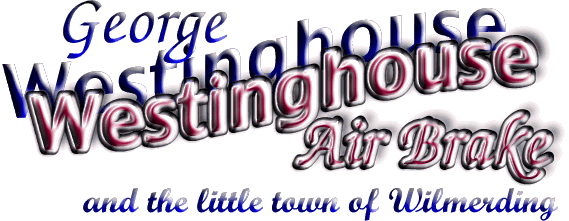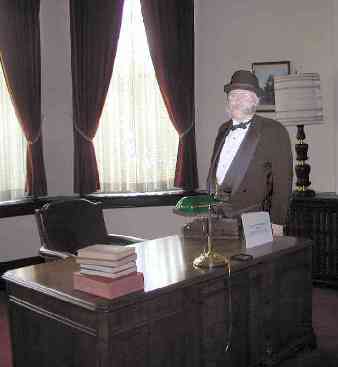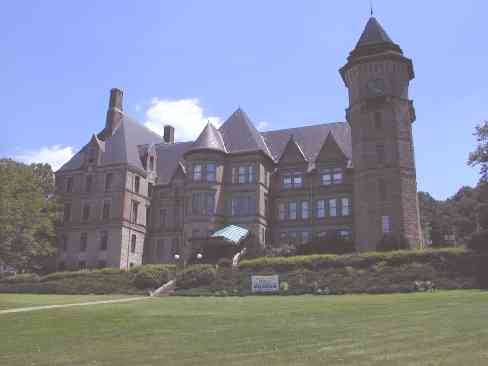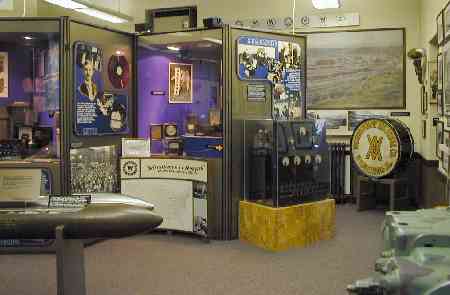

|
|
 George Westinghouse was a genius, no doubt about it. He was a genius engineer and a genius businessman. The air-brake, alternating current electricity, interlocking railroad switching, and so much more; were all developed and produced by Westinghouse and improved the lot of Americans and are all things that we take for granted today. He was a modest man and did not seek fame when he was alive;and now, when surveying the history of Pittsburgh, he still does not always get his due. He was born and raised in central NY state, where his father owned a factory that manufactured harvesting machines. His father's machine shop was more of an education to young George than was his formal schooling. He joined the Union army at 17; first as a cavalry scout, later he was a naval engineer. After the war he briefly attended Union college in Schenectady, N.Y. but found the machine shop more attractive. He returned to Schenectady and invented a rotary engine there, and received his first patent at age 19. Railroads had opened up the American Continent and people did a lot of traveling by train back then. George was no exception and it played an important role in his life. Some of his early inventions were inspired by incidents that occurred on the train; one was a device to replace cars back on the track after they had derailed, designed after his train was delayed by a derailment. Another time he was aboard a train which came upon a train wreck. Talking with the train men, George learned that the problem was in the braking system. At that time each car had it's own brake, and the breakman was forced to leap from car to car and set each brake individually. Accidents happened because there just wasn't time to stop. George gave this problem much thought. First he thought of coupling all the brakes with a chain, but it did not work. Then he thought of using the steam power of the locomotive to run steam brakes on the cars. It was not successful because in cold weather the steam condensed and froze before reaching the brakes. And then he read about a technique used in drilling dynamite holes in a tunnel being constructed in the alps. A steam engine provided air power which was piped 3000 feet into the tunnel to run the drills. "If the air can travel 3000 feet in the tunnel, it can travel 3000 feet along a train" he thought. Thus the Westinghouse air brake was born. But it had to be tested on a full size train. He went to Cornelius Vanderbuilt, president of the New York Central to ask to borrow a locomotive and 4 cars. "Are you trying to tell me that you can stop a train with just air?" Vanderbuilt demanded. When George said "yes" he was thrown out of Vanderbuilt's office! Eventually the Panhandle railroad, which ran between Pittsburgh and Steubenville, agreed to allow George to install his air brake on one of their locomotives and 4 railroad cars. The test run was arranged. The train was filled with officials from the railroad, and George Westinghouse - "that crazy brake man". The train stopped at the first station, as promised, and the second one, too, without a problem. On the way to the third station, the train encountered a horse & carriage that had become stuck at a crossing. The engineer had to apply the brakes suddenly, and hard! The train shuddered to a screeching stop, knocking most passengers to the floor. When the officials disembarked and saw the reason for the sudden stop, they were convinced that the air brake was a huge improvement over the old system.  Orders began to pour in. George Westinghouse built his first factory in Pittsburgh, but later he needed to expand, bought land east of the city and erected a huge plant there. At the same time, he built a town around the plant; shops and executive offices nearby, and across Turtle Creek, rows and rows of neat little brick houses. The town was named "Wilmerding" after the family that had sold him the land. It was unlike other factory towns of that era; the stores were privately run and the workers were not bound by the scrip system. The houses were rented from the company, and could be purchased at very low cost. And unlike the other Pittsburgh industrialists of the day, Westinghouse was an enlightened employer. He instituted the half day off on Saturday, and paid vacations, pensions for retirees, their wives or orphans. He established sickness and accident benefits. He was among the first to establish student training courses in his shop and to introduce incentive plans. He recognized the basic principle of collective bargaining. George Westinghouse went on to other inventions -- over 350 of them! and to setting up other buisinesses to manufacture his inventions. Westinghouse Electric, Union Switch and Signal, Allegheny County Light Company, to name a few of the companies he established. . Westinghouse, with his alternating current system of electrical distribution (he had hired Nicholas Tesla for this project) competed successfully against Thomas Edison who was espousing the direct current system. Westinghouse won the contract to electrify the Chicago World's Fair of 1892, which proved that alternating current was feasible. At its peak, over 17,000 people were employed in the Westinghouse valley, and most lived in East Pittsburgh, Turtle Creek and Wilmerding; towns that are hidden under the Westinghouse Bridge. Built in the 1930's, the Westinghouse bridge spans the valley - the longest single span concrete bridge in the U.S. Since the 1960's, business in the valley has declined; the Westinghouse plant is now closed. But, unlike some other sections of Pittsburgh that have seen a decline, Wilmerding is not a "ghost town". There is a strong sense of community there, as families have remained even after the plant closed, keeping their little brick houses in good repair. The streets and shops are also kept up well, and the Station Break Cafe is well known far outside the boundaries of Turtle Creek and Wilmerding. And residents, who live there today, fondly call themselves "Wilmerding-a-lings" Still looking down on it all is the Westinghouse Castle. First built as a community center for Wilmerding with some Westinghouse executive offices on the upper floors, it burned down in 1896. By that time the community had a YMCA and when the castle was rebuilt it was given over entirely to Westinghouse offices.  Today one can tour a small museum devoted to George Westinghouse, his inventions and his companies which is located on the ground floor of the castle. In it are examples of many of his inventions, copies of his patents, samples of Westinghouse appliances. Admission is only $3; there is parking, but no cafeteria; you'll have to walk down the hill to the Station Break Cafe for a bite to eat. The story of the Pittsburgh Industrialists of the end of the 19th century generally is not a pretty one. We think of the Homestead Strike and the Johnstown flood; both are events that are part of the family history of many Pittsburgh families and are not forgotten. It is refreshing to learn of George Westinghouse, who was motivated not by greed or lust for power, but by a desire to help mankind. |
|
Westinghouse Museum |